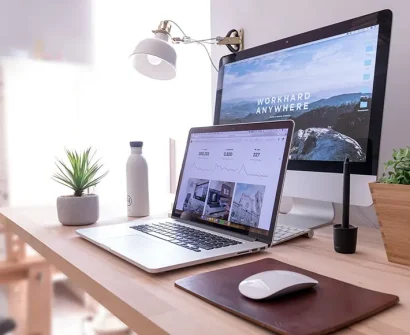
One of the common questions that I get asked is “Do I really need to learn coding in order to become a freelance web designer?” In short, the answer is no.
Constructing a career in web design was previously equivalent to the time spent (or even years) of battling with HTML, CSS, and JavaScript. However, what has changed is that no-code tools are so powerful that they have completely revolutionized how people create their websites in 2025.
How about if you postpone your freelance web design career and decide it is better not to touch the coding side because it is too complicated? Then I would tell you that the good news is that you can create beautiful, professional websites without writing a single line of code.
Why I Still Think Freelance Web Design Is Worth It
Listen, I am not going to lie to you. The web design world is cutthroat. Nevertheless, after several years of being in this business, I still think that it is one of the most brilliant ways to penetrate the tech field or simply set up a sideline that is flexible.
This is the main reason it is still functioning:
The demand just keeps going. A website is necessary for every business. I’m referring to your local dentist, that new coffee shop that just opened, online trainers, consultants, e-learning stores. They all need websites that do their jobs and are visually appealing.
You are able to be truly flexible. No travelling to work, no dress code, no asking for permission to leave for a while. You decide when, where, and with whom you want to work.
The growth is impressive. I have witnessed the people who first made $300 websites go on to create agencies that make $100,000 or more annually. The route from being a newbie to becoming a thriving entrepreneur is quite straightforward.
Moreover, honestly, It is easier than ever to start a business because of the current tools.
How No-Code Tools Changed Everything
The majority of people do not know that the industry of web design has been greatly changed by the visual, drag-and-drop tools.
More than 43% of all websites on the internet are powered by WordPress. The platform will still be there in the future, and businesses love it because it is a well-known and dependable solution.
Elementor is the place where the amazing things happen. It is a WordPress plugin that allows you to create the custom websites just by moving the elements on the screen visually. No coding is necessary, but the final product looks like it cost $10,000.
Webflow is one more good choice, though I mostly suggest WordPress + Elementor to freelancers as it is cheaper and has a big user base.
These tools have completely evened out the playing field. By just mastering the visual design tools, you can now go up against those developers who have spent years coding.
What You Actually Need to Learn (Spoiler: It’s Not That Much)
So, if coding is not an option, what do you really need to know? The truth is the list follows:
- Sense of basic design. Understanding needs to be done on the basis of what is good and what is not. Color combinations, typography, and the way the information is presented for the easy reading are all part of the concept.
- Experience from the user’s point of view. Your websites must be user-friendly. That involves understanding how someone moves through the site, finds information in places where it is expected, and guiding them there to take action.
- Responsive design. Websites should be equally good looking on smartphones, tablets, and laptops. Luckily, contemporary instruments make most of the work automatically.
- Communication skills with the client. It is very important. You have to ask the right questions, be clear about your expectations, and give what you promised.
- Project management at a basic level. Keeping track of deadlines, feedback and revisions without losing control of yourself.
The positive side? None of these things require years of learning. You can be reasonably skillful with concentrated learning in a short period of time.
Your Step-by-Step Path to Freelance Web Design
Alright, here’s how you actually do this thing:
Step 1: Pick Your Tool and Learn It Well
I would suggest initially going with WordPress and Elementor. It is very easy for a novice to use, amazingly versatile, and the vast majority of companies are already utilizing it or would be glad to use it.
Just say no to learning multiple software simultaneously. Choose one, master it and then move on to the next one.
Step 2: Build Practice Websites
Most people often make a big mistake here. Without showing any work, they expect clients to come to them right away.
Start creating practice websites: Develop a portfolio site for your personal use, design a website for a non-existent restaurant, create a landing page for a made-up consulting business. The main point is to create websites that merely look like businesses’ websites.
Step 3: Create Your Portfolio Site
Think of your portfolio as your resume. It should represent your greatest achievements, whether these are only practice projects at the moment.
Also, don’t forget that your portfolio website must be a reflection of your professionalism. If you are not able to create a decent website for yourself, how could somebody expect you to make theirs?
Step 4: Find Your First Real Clients
This is where the rubber meets the road. Here are the approaches that actually work:
- Local businesses are often the easiest starting point. Visit businesses in your area and look at their websites. If they’re outdated or nonexistent, you’ve found a potential client.
- Freelance platforms like Upwork and Fiverr can work, but expect heavy competition on price. Focus on providing value, not being the cheapest option.
- Networking in online communities, Facebook groups, and LinkedIn can lead to referrals and long-term relationships.
Step 5: Keep Getting Better
The web design world moves fast. New trends, tools, and best practices emerge regularly. The freelancers who succeed are the ones who keep learning and adapting.
How We Can Help You Skip the Learning Curve
One difficult aspect of self-study in web design is that you could be drowned in information and still do not know how to go about it. You will find tons of tutorials, blogs, and videos but not knowing where to start or what to focus on could be the biggest hurdles.
This is the point to our Webolearn WordPress + Elementor course. Instead of a scattered and confusing way of doing things by surfing from one tutorial to another, you get a practical and easy to understand guide tailored for the people who want to be their own boss in the web designing field.
What you’ll actually learn:
- Setting up WordPress properly from day one (most tutorials skip the important details that matter for client work)
- Mastering Elementor through hands-on projects, not boring theory
- Building a portfolio that attracts paying clients
- The business side: pricing your services, writing proposals, managing client relationships
By the end, you won’t just know how to build websites. You’ll know how to run a profitable freelance web design business.
The Reality Check You Need
I want to tell the truth to you about one thing: it is hard to be a successful freelance web designer. The software makes creating websites a piece of cake, but a freelance business is still your job that takes effort, patience, and persistence.
Sometimes you will have to twirl with demanding clients. Your projects may turn out not to be perfect. You will require to promote yourself constantly and get new jobs.
Yet this is what I have realized after a long time in this industry: if you are ready to put the energy into learning the skill and building up relationships with clients, freelance web design can give you the level of freedom and money that most of the traditional jobs cannot give.
Ready to Get Started?
The barrier to entry for freelance web design has never been lower. You don’t need a computer science degree, years of coding experience, or expensive software. You just need the right tools, some design sense, and the motivation to learn.
If you’re ready to take this seriously, check out our WordPress + Elementor course and start building the freelance career you’ve been thinking about.
The question isn’t whether you can learn this. The question is whether you’re ready to start.



